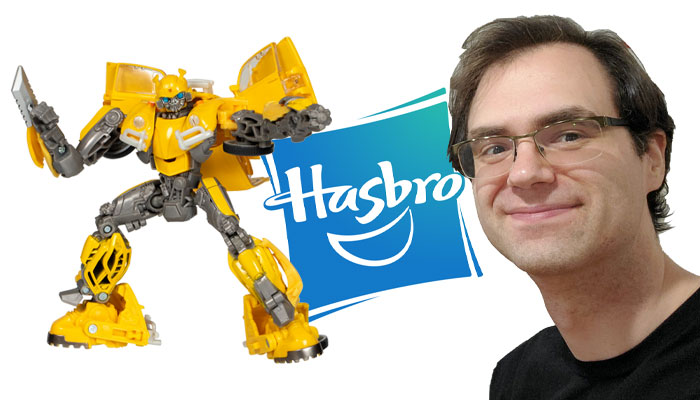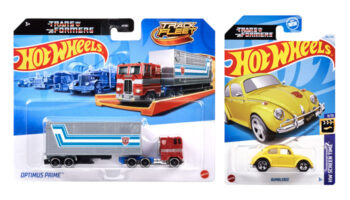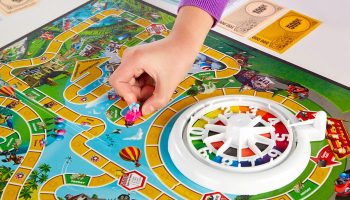Hasbro’s Evan Brooks takes us inside the design process on TRANSFORMERS – and reveals his most underrated creation!

Evan, it’s great to connect. Before we dive into all things TRANSFORMERS, can you talk us through your route into toy design? Was it always part of the plan?
Great to meet you, Billy! It honestly wasn’t in my plans as I didn’t realise it was a career path until I was a junior in college.
I’m from Cincinnati, Ohio originally, which is where Kenner used to be located – and Hasbro acquired Kenner back in the early Nineties. It just ended up being a happenstance that there were several alumni of my college that went on to be Hasbro toy designers from Kenner, and they stayed connected with many of my professors at the Columbus College of Art and Design – which is where I studied Illustration. Our 3D illustration class would then become a toy design class, and we’d hold a toy design competition with the top five being allowed to interview with the visiting alumni Hasbro designers for a summer intern position.
Amazing! And you made the top five?
I did make the top five and got the opportunity to interview with Hasbro, but I didn’t get the intern position – a close friend of mine did. He ended up getting hired and reached out to me a few years later when there was an opening on the Kre-O team. I applied and got in! From there, I’ve bounced around and worked on many brands and finally got my claws into TRANSFORMERS which was always the dream.
Can you talk us through your current role and the brands you work with?
I’m a Product Designer on the TRANSFORMERS team. Specifically, I work on what we consider more of the “fan” side of items. Studio Series, Exclusives and Haslabs, which are geared to be more traditional action figures.

Were you a fan of the brand before joining Hasbro?
I’ve been a fan of the TRANSFORMERS franchise for as long as I can remember. Some of my earliest memories are from watching episodes of the G1 cartoon that were in syndication. I was hooked for life and was always following the brand, even into adulthood.
What usually kick-starts the design process on a TRANSFORMERS item? I’m imagine the transformation itself steers things?
I usually get the sort of “chicken or the egg” question on which should come first when designing a TRANSFORMERS toy. As in: “Do you start with Robot or the alternate mode?” The truth is you start with both. The beginning of designing a figure is roughing out both the Robot and alt mode – and keeping them side by side as you look for areas that overlap which then steers your conversation. Obviously, scale and budget come into play as a Deluxe is less complex than a Leader scale figure, so you must consider piece count as well when you’re developing a figure.
Amazing. And what does the collaboration with Takara Tomy look like when it comes to the design process?
We have a very strong relationship with Takara Tomy as we have collaborated on every TRANSFORMERS product since the brand’s launch in 1984. During the development process of this beloved toy brand, it takes about 18 to 24 months from ideation to the final product.
There are several factors that we consider when developing a new toy, including, whether it’s tied to entertainment – such as this year’s TRANSFORMERS ONE film – a TRANSFORMERS character that fans have voiced interest in on social media, or celebrating an anniversary like this year. For example, our 40th Anniversary items – such as new additions to the Legacy United product line – are inspired from decades of TRANSFORMERS animated history.

You mention this year being the 40th anniversary of the brand. Has the design of these toys evolved over the decades? Are today’s lines more intricate than those that came before?
The toys have evolved in the sense that we now have a wide variety of product lines that appeal to different groups and tastes for all ages. For example, with products based on the new TRANSFORMERS ONE film, our Studio Series Deluxe Class Elita-1 figure caters to those fans who seek classic conversions with highly detailed features and articulation… While the Power Flip Optimus Prime (Orion Pax) figure can be converted by simply flipping the figure.

Why do you feel the brand continues to thrive after 40 years?
The TRANSFORMERS brand has always been unique in its ability to adapt and change, while staying true to its core concept that robots can convert into other forms. The brand has always been innovative and constantly reinvented itself. For example, there are many fun toy options to convert bot characters into their alternative modes that cater to our diverse fanbase needs today, like the simple 1-Step Flip Changers from the TRANSFORMERS: EARTHSPARK line to implementing new technologies that keep the classic multi-step conversion fresh among fans that have embraced it throughout the decades.

The products on shelves have been bolstered by entertainment content over the years, from an animated mini-series to full-feature films and engaging digital games that all follow the latest technology. Additionally, the strong licensee program established during the 1984 Toy Fair toy debut has allowed for continued partnerships, making TRANSFORMERS a beloved and timeless franchise for multiple generations.
This year as part of the 40th celebrations, fans can enjoy exciting digital games like TRANSFORMERS: Galactic Trials and TRANSFORMERS x Squad Busters from Supercell, premium consumer products through our collaborations with Converse, Mattel, LEGO and Robosen, plus so much more. That ability to evolve with our surroundings enables the TRANSFORMERS franchise to resonate with fans and remain ‘More Than Meets Eye’.
Can you talk us through a particular design challenge on a recent launch that you’re proud to have cracked?
A big one that comes to mind is how we handled the design of our SS86 Ironhide and Ratchet. Traditionally, these characters turn into very boxy vans – when they have Earth modes – and there’s a lot of mass that must translate over from robot to Van mode. The last few releases used a big shield piece to become the entire roof of the vehicle mode (or some other parts forming) so the robot mode didn’t need to be compromised.

Kunihiro san over at Takara Tomy had a brilliant idea for the leg and feet conversion that used several folding panels that could compact down in robot mode to give them a very clean silhouette – but then unfold to become the sides and roof of the vehicle mode. It felt like we were finally able to create the G1 toy we all imagined from watching the show.

They look terrific. Well done! Is it quite a specialist position to work in design on this brand? Or does it provide you with skills or experience that is transferable to other toy brands?
TRANSFORMERS toys are very unique when compared with other toys and action figures. The ability to convert from robot to alternative forms such as a car, spaceship and more requires creative ways to make it become a reality. We look at what has been successfully done in the past and find innovative ideas that continue to make the brand fresh and exciting. It takes skills to continue pushing the envelope, but I believe anyone can become a toy designer with hard work, learning the craft and putting your mind to it.
Absolutely. Evan, this has been great. I have one last question! What is the most underrated TRANSFORMERS product you’ve worked on? We can give it some love here!
Oh, that is a tough question… Underrated, hmm… There was an exclusive item featuring Kaskade and Javelin – some obscure comic book characters – that I loved and were really a lot of fun to work on.

It was a cool 2-pack that our packaging team designed to sort of look like a fighting game “VS” screen. I think that they were perhaps just slightly too obscure, so it is still quite an easy item to find! Ha!
Ha! Any sales of those over the next few weeks we can claim credit for here! Thaks again Evan.

–
To stay in the loop with the latest news, interviews and features from the world of toy and game design, sign up to our weekly newsletter here



























